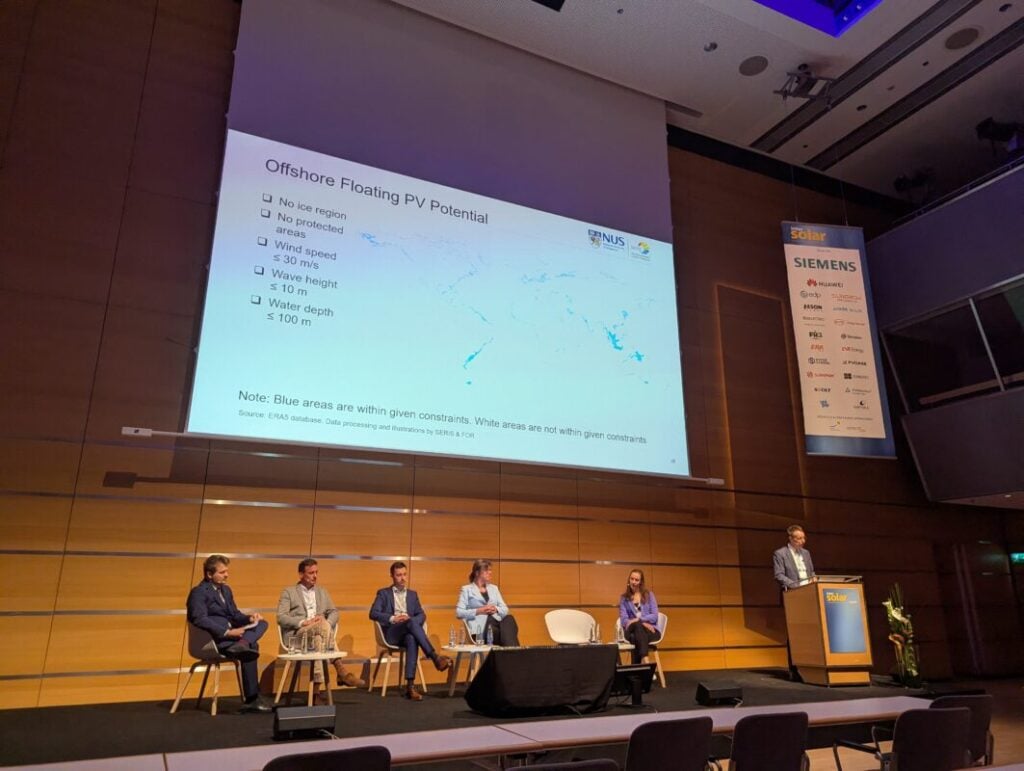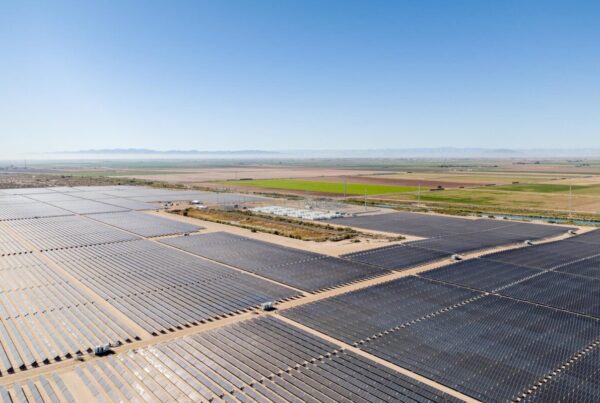“If we do a conservative assessment, and only cover 10% of suitable reservoirs, the total potential capacity is 22TW; that would generate around 33,000TWh a year in PV generation, which is about the electricity consumption of the world today,” said Reindl.
“We also calculated the savings in water – because you have a reduction in evaporation from the reservoir – and that number is about 5% of the global water demand today, that we could provide by just adding these floating solar systems.”

He went on to highlight that much of this capacity could be built on a relatively small area of water. By eliminating a number of areas of ocean based on wave height, wind speed and absence of ice, accounting for the vast majority of the world’s water, only a fraction of the world’s water surface would be suitable for FPV, as shown in blue on the map above, but that this should not dissuade investments in the sector.
“This is all in the terawatt-scale; the potential is enormous,” said Reindl, of a sector that has around 9.2GW of cumulative installed capacity in operation.
Making the business case
Despite this considerable potential, the fact remains that FPV accounts for less than 1% of the world’s operating solar capacity, according to another speaker, Vincent Grumetz, EMEA managing director at Ciel & Terre International. Michele Tagliapietra, head of product management for FPV at BayWa r.e., went on to point out that project finance is a key reason for this.
“Floating PV is more expensive than ground-mounted, but there are other reasons to do floating and other ways to make a floating project viable technically and financially,” said Tagliapietra. “The capex is higher than ground-mount – it’s reducing – but it’s unlikely the gap will be fully closed.”
“What’s more complex is to find the right offtaker,” he continued, echoing a discussion held earlier in the day regarding growing complexity in the solar power purchase agreement (PPA) space.
“In most cases, your normal PPA, which might work for a ground mount project, is not enough to make the business case viable. Incentives and contract for difference (CfD) options are likely needed to make the project viable.”
However, rather than presenting this as an insurmountable obstacle to FPV potential, he discussed comments made by Reindl that this should encourage the creation of different, and more tailored, offtake agreements and financial mechanisms.
“As Reindl says, there are different lakes where you can install floating solar, and the way to make it work is to do self-consumption behind the meter for industrial users on the lake,” said Tagliapietra. “That doesn’t rely on an offtake structure like a PPA, but reduces the energy bill of the activity near the lake.”
Sarah Kluge, project manager at the Dutch Marine Energy Centre (DMEC), suggested that co-locating offshore solar projects with offshore wind projects could be another way forward, as developers look to take advantage of a shared grid connection and offshore platform to minimise the considerable capex of a floating project.
Using the example of a hybrid solar-wind project off the Dutch coast, which is set to come online in 2031 and combine 705MW of wind capacity with 700MW of solar capacity, Kluge noted that DMEC forecasts the project to export 15% more power annually than separate projects would do.
Crucially, the monthly curtailment ratio would fall by 3%, compared to standalone projects, as the complimentary nature of wind and solar generation means a co-located production profile is much more consistent than those of separate projects: as wind production declines in summer as wind speeds slow, solar production grows as sunlight hours increase.
“What does our energy production profile look like?” asked Kluge, pointing out that the project’s capacity factor is expected to increase from below 40% to about 50%. “Offshore solar can nicely fill in there.”
Improving performance and profits
However, a number of speakers pointed out that more can be done, both to improve the technical and financial performance of FPV assets. Kluge noted, for instance, that the DMEC settled on a project with a combined 1.4GW of capacity because a combination of 700MW of solar capacity and 705MW of wind capacity yields the lowest potential curtailment rate.
Considering Reindl’s comments that the potential of FPV ought to be measured in terawatts, rather than megawatts, cutting curtailment will be key if hybrid renewable projects like these are to become more commonplace. This concern also echoes earlier sentiments expressed by the International Energy Agency (IEA) that gaps in both technical knowledge and legislative clarity have slowed the adoption of FPV.
“There is an intention and a push for renewables and for dual use of land and water [in Europe],” added Tagliapietra, agreeing that the combination of different technologies at the same project can create legislative confusion.
“There are public consultations ongoing from the European Commission to push this even further, and an EU directive that established the concept of a ‘renewables acceleration area’. The general framework is there, but the implementation for specific countries is still not homogeneous. In some countries, there are specific regulations that have been implemented,” he said, referring to the policy framework in Germany as “missing” and “unclear”.
“In some countries you have an incentive but not a regulation, in others you have a regulation but not an incentive,” he said, calling for greater legislative support. “In lucky countries, you have both; in unlucky countries, you have neither.”





